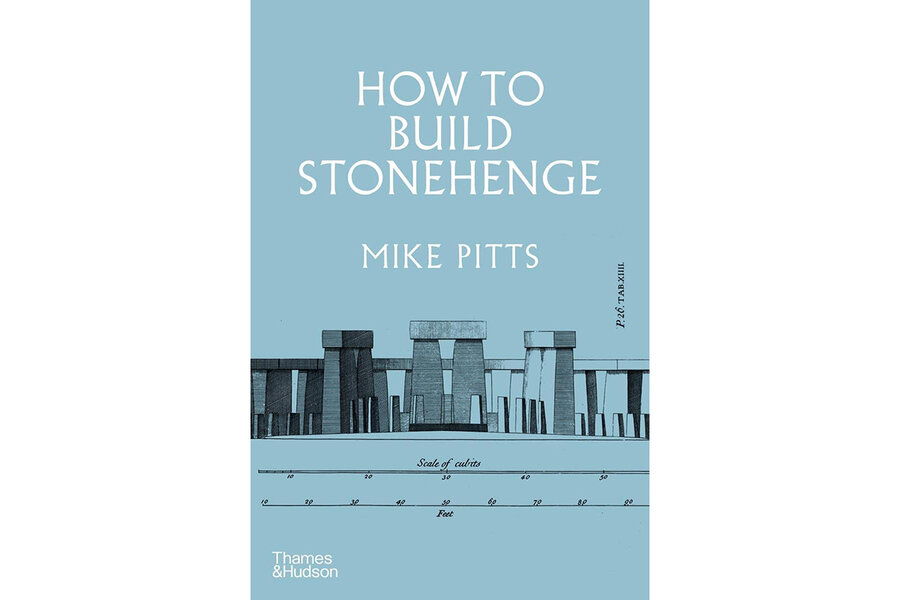We can’t know the ‘why’ of Stonehenge. This book reveals the likely ‘how.’
On Salisbury Plain in Wiltshire, England, rests an extraordinary monument that has puzzled and inspired people for millennia: the circular set of rocks known as Stonehenge. The iconic scene, so precisely designed and constructed, provokes a litany of questions: What motivated the Neolithic people to create such a thing? Where did the huge, 20-ton stones come from? How was it built?
Archaeologist and journalist Mike Pitts, who has studied the ruins for decades and co-directed excavations at the site, offers readers an in-depth assessment in “How To Build Stonehenge.” While he doesn’t try to answer the first question of why – writing that “imagination is the only limit” to finding a motive – he does break down the second question into several components: how the stones were obtained, how they were moved to the site, how the structure was erected, and how its construction has changed over time. Overall, the book feels geared toward readers who relish granular technicalities of geological analysis. Yet for those who are more interested in the human aspects of Stonehenge’s construction, Pitts’ review of how megaliths have been handled over time still proves noteworthy.
For example, studies have identified the Preseli Hills in Pembrokeshire, Wales, as the place where the smaller ring of rocks known as bluestones were quarried. The bluestones, which weigh an average of 2 tons apiece, were somehow transported to Salisbury Plain, which lies 140 miles from the Preseli Hills. (By comparison, the larger slabs, known as sarsens, weigh 20 tons and are thought to have come from Marlborough Downs, about 20 miles north of Stonehenge.) To begin to understand how the bluestones could have been moved such a distance, Pitts turns to another corner of the globe: the Indian Ocean.
Over the past century, people in Madagascar, India, Myanmar, and Indonesia have raised rock monuments with stones similar in size to those of Stonehenge. Archaeologist Ron Adams spent several years in the early 2000s on the Indonesian island of Sumba, watching hundreds of men transport one rock slab at a time as part of a wealthy man’s future burial site. That process sheds light on how the builders of Stonehenge might have transported their heavy stones.
In Indonesia, a core group of about 40 laborers typically stayed with the rock slab over the entire route, working shoulder to shoulder for a month or two as they pulled their cargo by rope across wooden trackways. Often, there would be additional hands at the start of the trek, when a community leader or priest would give a ceremonial blessing. Then as the trip progressed, the laborers would be visited or joined by the locals: a slew of caregivers who would feed the workers, house them, and perhaps replace those who could not afford to spend any more time away from their families.
When their ultimate destination was finally in sight, additional people would show up to have the honor of participating in such a momentous occasion, and to enjoy the celebration afterward. As Pitts explains, the fact that there were more men than necessary to do the job was not accidental. “A tomb owner’s aim,” he writes, “is to make an impressive spectacle, and stones might deliberately be moved slowly, the better to show off their wealth. Everyone wants to be associated with the achievement, and contributing to the effort sets up a debt to be repaid.”
Granted, the ancient builders of Stonehenge may have experienced a wholly different social dynamic, but at least this image from the tropics provides a very educated guess of what it could have been like.
Over the course of the book, two patterns become increasingly apparent: the incredible commitment of the builders of Stonehenge, who defied so many obstacles in order to complete it, and the enduring passion of the many individuals who have studied, excavated, tested, filmed, and visited the monument over hundreds of years.
The modern picture we see today is quite different from that of 5,000 or even 100 years ago. Unfortunately, over centuries the stones have been abused by visitors, who carved their names and prized small chips from the edges. Pitts explores the question of how best to preserve a piece of history like Stonehenge, which has been altered by private landowners and public agencies. In the 1950s and ’60s the British Ministry of Works raised five fallen megaliths, straightened other parts back up, and set the stones into concrete bases, but it also inadvertently knocked over a 16-ton slab in the process.
While Pitts muses on the mistakes made during 20th-century preservation attempts, and on the problems perpetrated by overzealous visitors, he concludes that “fraught conversations between past and future, mystery and understanding, and permanence and mutability, are what Stonehenge is for. As it did thousands of years ago, today the monument draws people together from afar in a common mission to reflect and be challenged, to strive to appreciate different cultures, to escape the present, to marvel at antiquity, and to ponder the future.”






